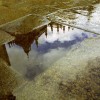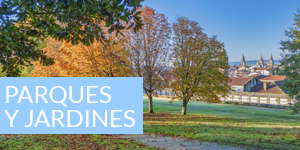- Accede I
- Regístrate I
- carrito
Historia de la Catedral
El antecedente más remoto de la Catedral fue un pequeño mausoleo romano del siglo I en el que se dio sepultura a los restos del Apóstol Santiago después de su decapitación en Palestina (año 44 d.C) y tras su traslado por mar hasta las costas del finis terrae. Durante siglos, la cámara subterránea y la necrópolis que la rodeaba fueron asiduamente visitados por una pequeña comunidad cristiana local, de la que poco o nada se sabe, pero que debió ser diezmada hacia el siglo VIII.
En el año 813 (según versiones, 820 y hasta 830) se produjo el milagroso descubrimiento de las reliquias del Apóstol bajo la maleza del Monte Libredón. Las encontró un ermitaño que vio allí signos celestiales. Avisado por el obispo de Iria Flavia, el rey astur Alfonso II mandó a levantar una primera capilla de piedra y barro junto al antiguo mausoleo. Este templo recibió en el 834 un Preceptum regio que lo convertía en sede episcopal y le otorgaba poder sobre los territorios próximos. A su alrededor, buscando su protección, comenzaron a establecerse los primeros pobladores y grupos monacales de benedictinos encargados de la custodia de las reliquias. Eran los primeros pasos de la futura ciudad de Santiago de Compostela.
La primera iglesia enseguida se quedó pequeña para acoger a los fieles, por lo que entre el año 872 y el 899 Alfonso III El Grande hizo construir un templo mayor. Pero esta segunda iglesia fue destruida por el ataque del caudillo musulmán Almanzor en 997. El obispo San Pedro de Mezonzo la reconstruyó en 1003, en un estilo prerrománico. Este tercer templo estaba aún en pie cuando el auge de las peregrinaciones y las riquezas de Santiago, que ya era uno de los señoríos feudales más grandes de la Península Ibérica, permitieron comenzar a construir en 1075 la catedral románica que hoy se conserva, cuarto edificio sagrado sobre el antiguo sepulcro.
La Catedral románica
El rey leonés Alfonso VI y especialmente el primer arzobispo de la ciudad, Diego Gelmírez, impulsaron de tal manera la Catedral, la vida urbana y las peregrinaciones, que puede hablarse del siglo XII como el de mayor esplendor de la historia compostelana. Esta vez no se conformaron con un santuario que albergase las reliquias, sino que diseñaron una gran catedral de peregrinación siguiendo el estilo que se extendía por el Camino de Santiago. Por ella desfilarían los mejores constructores del Románico hasta llegar al Maestro Mateo, autor de los últimos tramos de las naves, las torres defensivas del oeste, la cripta y, sobre todo, del Pórtico de la Gloria, un conjunto escultórico sin igual en Europa que aun hoy preside la entrada oeste.
Cuando fue consagrada en el año 1211, la Catedral ya gozaba del privilegio de la absolución plenaria, otorgado en 1181 por el Papa Alejandro III a todo el que visitase el templo en un Año Santo Jubilar. También concedía a los fieles un valioso documento que acreditaba haber recorrido el Camino de Santiago y aseguraba el derecho de asilo en la ciudad. Convertida en meta de salvación de la Cristiandad, la catedral evolucionó con tal vitalidad que fue capaz de impulsar la construcción de calzadas, hospitales, albergues, mercados y burgos enteros a cientos de kilómetros de distancia, en las rutas que transitaban los peregrinos para alcanzarla.
Con el tiempo se irían añadiendo a la planta románica elementos góticos, renacentistas y especialmente barrocos, gracias al incesante flujo de dinero del arzobispado y de los mecenas, que encontraban en las capillas lugar de oración y eterno descanso. Mientras la estructura de las naves se conservó prácticamente intacta, el número y espacio de las capillas fue adecuándose a las necesidades del culto. En el convulso siglo XIV la basílica adquiriría trazas de fortaleza, con torres defensivas como la actual Torre del Reloj. Con el Renacimiento, impulsado por el arzobispo Alfonso III de Fonseca, se levantó el claustro definitivo, que sustituyó al claustro románico y modificó todo el lado sur y sureste del templo. Fue época de reformas internas y adición de retablos, púlpitos y esculturas para mayor gloria del culto al Apóstol.
La magia del Barroco
La mayor revolución estética llegaría al templo en tiempos del Barroco, que comenzó en 1660 por transformar el altar mayor y la cúpula; para luego dar forma a los órganos, trazar el lienzo de la Puerta Santa, embellecer la Torre del Reloj y alcanzar su mayor esplendor con la culminación, en 1750, de la estampa más icónica de la catedral: su magnífica fachada del Obradoiro.
Fue también obra de los maestros barrocos de la Catedral –Vega y Verdugo, Domingo de Andrade, Fernando Casas y Novoa- el trazado definitivo de las plazas monumentales que rodean al templo y de muchos de los edificios colindantes. Bien puede decirse que el Barroco saltó de la catedral a las plazas, a los monasterios y a las casas nobles, para convertir a Compostela en la urbe imaginativa, escenográfica y dramática que hoy es reconocida como ‘la ciudad barroca por excelencia de España’.
Tras dos mil años de historia como centro espiritual, y casi mil de su actual edificio, la Catedral se muestra hoy como un conjunto heterogéneo de espacios y elementos estéticos que dejan ‘leer’ en la piedra la extraordinaria historia compostelana. Y es que en su larga existencia el templo ha sido escenario de toda clase de episodios sacros y mundanos, que van desde la coronación de los reyes de Galicia en la Edad Media hasta el acuartelamiento de los soldados franceses durante la Guerra de Independencia, pasando por siglos de concordias y discordias, exaltaciones y linchamientos, conspiraciones políticas y esplendor religioso, ataques incendiarios y costosas campañas de embellecimiento, pompa y beneficencia, donaciones y expolios, cobros de prebendas y patrocinios, solemnes ofrendas y, sobre todo, incesantes peregrinaciones hacia la tumba del Apóstol.












